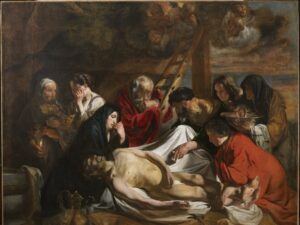Jacques Jordaens: Ablution and Anointing of Christ
We stay in the Maagdenhuis, Van der Meere Roomas in the Vander Meere room (if accessible); nowhere else do we get so close to a Jordaens painting.
In his estate, Jordaens donated this work to the Chamber of the Parish Poor/Camer der Huysarmen, as his son-in-law explained: ‘for some good affective inclination that the late Jacques Jordaens had towards the poor’.
In passing, please pay attention to the numerous works of anonymous or unknown masters. In a sense, they are the counterpart of the well-known pupils and collaborators to whom no established or known work can be attributed to. At the same time, these anonymous artists illustrate that painting was an industry, a craft, a production centre of inspiring works – with religious or historical themes, fit to hang in your workspace or office, or even in your own private home.
In the Van Der Meerezaal you come face to face with a large painting by Jordaens from 1620-1623: ‘Lamentation of Christ’, a general theme in Christian devotion and art history. This one carries its own title: ‘The ablution and anointing of the body of Christ’.
‘Burying the Dead‘ is a seventh, explicitly added Work of Mercy for Catholics. Doing good deeds is the best Catholic way to find God. This is commonly called ‘finding one’s salvation’ or, more explicitly, ‘earning one’s heaven’. After all, Jesus said: “Truly I tell you, whatever you did for one of the least of mine, you did for me” (Mt., 25:40). Jordaens was very sensitive to statements like this.
He most likely made this painting for himself or at least he kept it at home, for it was part of his estate. Then, passing through the Chamber of the Parish Poor, an early precursor of our public welfare agencies, the painting ended up here, together with a large amount of money. Jacques’s son-in-law Johan II Wierts explained these donations as “for some good affective inclination that the late Jacques Jordaens had towards the poor.” Something worth repeating today.
But let us take a look at the subject of the painting: immediately after the descent from the cross, Jesus is laid in the arms of his weeping mother Mary. She is surrounded by two women with balsam herbs, by councillor Nicodemus leaning on the ladder and by Joseph of Arimathea, the provider of the tomb; we also see the apostle John and two women with a basin.
If we compare this ‘Pietà’ with other images on this subject, we are struck by the raw realism of the figure of Jesus, which largely fills the foreground. Yet – remember the title – the body has already been washed, so that we are not faced with the crudest traces of scourging, crucifixion and lance stabbing. Also, a small amount of anointing from the jug has already been applied; this explains the yellowish light on the torso.
The event takes place shortly before sunset; but the light falls – from the right – rather dramatically on the scene. Perhaps Jordaens thought of the light fall in the room in his house, where the painting would be hanging.
Several figures are highlighted and a single detail stands out: it is the outstretched hand of Joseph of Arimathea and its pronounced shadow on the shroud. The folds in the cloth are perceived to be moving slightly around the motionless body by means of different techniques of hard and some soft shadows.
The upper part of the painting, with the cherubs, looks different and that is easy to explain: the panel has been enlarged 30 years later at alle sides, both at the bottom, left and right, and at the top about halfway up the ladder!
On the left of it, you see a ‘Saint Jerome’, probably painted by a follower of Anthony Van Dyck; this artist could only imitate his master’s quality painting in the detailed portrayal of the head. The study for this portrait is on display in the Snijders&Rockox House on our North route.
Now, turn around for a quick look at ‘The Supper at Emmaus’ by Theodoor Van Loon (ca. 1582-1649). He was a contemporary of Jordaens and working in Brussels. He painted completely in the style of Caravaggio. The main subject with all its colours is illuminated by candlelight; the rest of the painting is cast in the shadow. Isn’t baroque ‘over the top’? Let yourself be grabbed by the hand on the right that invites you to join this group at the table.
-
- The Route South ends here; you could jump to the KMSKA (Fine Arts Museum) from this spot.
- For the continuation of our walk along Route East, you will cut through the courtyards of the former Saint Elisabeth Hospital and the Henri Van Heurckstraat to the Oude Vaartplaats. Turn left and you will arrive in the Maria Pijpelincxstraat. The Wapper/the ‘Bascule’ and Rubens House are now nearby.

